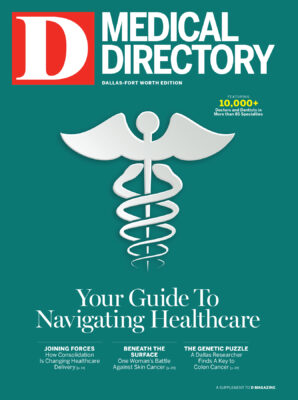In the mid-1990s, Doug Hawthorne watched a migration happen in North Texas. Families were flocking to live in outlying suburbs, dozens of miles from their jobs in the urban city centers of Dallas and Fort Worth. Hawthorne, the bespectacled and forward-thinking chief of what was then known as Presbyterian Healthcare Resources, noticed that healthcare providers weren’t keeping up with this migration.
Dallas-Fort Worth was populated with disparate hospitals and clinics that were concentrated in specific pockets. Healthcare was not coordinated and North Texans were no longer staying put in a single city. Instead, they were treating the entire region as a community. If hospital systems could merge, Hawthorne figured, a new network of providers could stretch well beyond a city’s borders, giving patients more options when they needed care.
Efforts to achieve such a goal weren’t unheard of. The Baylor Health Care System had unsuccessfully tried to join with Fort Worth’s Harris Methodist Health System and with Hawthorne’s Dallas-based Presbyterian system. Baylor’s executives couldn’t get their board to sign on. Meanwhile, insurance companies were already consolidating, making contract negotiations increasingly difficult for smaller hospitals.
So in 1997, after Baylor’s attempt at consolidation failed, Hawthorne brought Arlington Memorial Hospital and Harris Methodist into the Presbyterian fold. The three successfully merged into what is now known as Texas Health Resources, changing the landscape of healthcare delivery in North Texas. At last, North Texas had a coordinated healthcare system, a sprawling network where each individual location could access a patient’s medical records. Physicians had more options where they could perform procedures, in new locations that were often more convenient for themselves or their patients. And, Hawthorne won his bet on regionalism: THR now sees more patients than any other system in DFW.

Today, nearly 20 years later, Hawthorne’s vision has become the industry standard. THR has 24 acute-care and short-stay hospitals from as far north as Plano, as far south as Stephenville, and as far west as the Alliance area at the tip-top of Fort Worth. Dallas-based Baylor merged with Temple’s Scott & White in 2013, creating the largest nonprofit health system in all of Texas. The for-profit Tenet Healthcare Corp. has been on an acquisition tear, extending its network in Michigan, Central and West Texas, and Arizona. There are currently about 250 hospital systems in the U.S.—a number that some experts predict could shrink to as few as 60 in the coming decades.
These days, though, there aren’t many full-service, acute-care facilities left to acquire in North Texas that aren’t already part of a larger group. So the trend has trickled down to primary care providers, to outpatient clinics, to specialists. The environment of consolidation is becoming more nuanced, with highly regarded providers based in other states announcing partnerships with locals, betting on the region without having to sink significant capital into expansion efforts.
This is all quite heady, driven by statistics and population trends and federal quality mandates. But what does it mean at the base level, when a patient pulls up to their primary care doctor’s office and notices a new Baylor Scott & White logo above their name?
“For one thing, it means whereas [your doctor] used to do admitting in Baylor hospitals [as well as] Texas Health hospitals, he’s not going to offer you that choice, or at least not much, in the future,” says Allan Baumgarten, a Minneapolis-based hospital analyst who has studied Texas hospitals for decades. “The message to these doctors who are now employed within a large system is … to do as close to 100 percent of the care within our system, to avoid ‘leakage.’”
RECORD HOSPITAL PROFITS
When the system’s employed physicians refer their patients to affiliated hospitals, it means more money for the provider network. As a result, DFW hospitals are enjoying record profits, pocketing $1.998 billion in 2013 despite stagnant inpatient use, according to Baumgarten’s Texas Health Market Review, an analysis of hospital revenue and profits published each year since 1998.
Health system executives define their employed physician pool in business-speak as “access points.” By snapping up more outpatient clinics and primary care offices, they’re creating a larger presence of these access points in the community, linking a patient’s medical records across the system for when they need to see a specialist or have a procedure done. In a fee-for-service model—the traditional model where providers get paid per procedure rather than outcome—that translates into big bucks.
The ACA ushered in a new era of so-called “value-based incentives,” pushing population health management to the forefront.
For hospitals, the timing is right for consolidation. The Affordable Care Act ushered in a new era of so-called “value-based incentives,” pushing population health management to the forefront. Earlier this year, Health and Human Services Secretary Sylvia Burwell announced a goal of transitioning 30 percent of all Medicare reimbursements to value-based incentives by the end of next year, meaning providers will be paid more when they keep their patients out of the hospital.
This push has given rise to payment models known as accountable care organizations (or ACOs), which reimburse doctors for reaching certain quality incentives. For patients, especially those seeing an employed physician, it means they’re more likely to be shifted toward one of these plans. Prepare for care coordinators to follow up after a doctor’s visit like a helicopter parent: Did you fill your prescription? What’s your weight today? How are those smoking cessation classes going?
“Physicians didn’t take an oath to be responsible for the cost of care,” says Gary Brock, the chief operating officer of Baylor Scott & White Health. “It was their job to do everything they could to take care of patients. [Now] if you are in the Baylor Scott & White Quality Alliance, we are asking you to help us be responsible for the cost of care.”
It’s not hard to imagine that creating such a network is difficult for independent physicians. It takes significant resources: There’s data retention and analysis, paid care coordinators, cost studies, insurer negotiations. About 60 percent of all Texas physicians are independent practitioners, compared to fewer than half nationally. By becoming an employed physician, practitioners get to pass off the responsibilities of contract negotiations and reimbursements.
Employed physicians are responsible for a huge chunk of revenue for the systems, too. In an interview last year with D Healthcare Daily, Dr. Dan Varga, the chief clinical officer of Texas Health Resources, said just 10 percent of its affiliated practitioners are employed by the system, yet they account for about 35 percent of its revenue.
So it’s evident why employing doctors is attractive to hospital systems. But it also means less competition, which causes prices to spike. A report published earlier this year by the U.S. Government Accountability Office ranked DFW as the seventh most expensive market in the country in which to get a hip replacement (average adjusted spending of $41,129).
“There’s less competition, and all of this consolidation has given a smaller number of organizations more leverage and power in their local markets,” Baumgarten, the analyst, says. “They are using it to raise their prices, and that is a matter of significant concern.”

ABILITY TO COMPARE COSTS
On the positive side, there has never been a time in healthcare when patients have had more information at their fingertips. Insurance companies like UnitedHealthcare have built databases enabling plan holders to compare average costs for procedures at different providers. Employers are picking up less of the tab for their employees’ healthcare, and deductibles are climbing ever higher. The industry is shifting toward a consumer model. As a result, it has never been more beneficial for the patient’s bank account to ask about how necessary that MRI truly is.
To be sure, independent physicians still factor into this environment. They may not be part of a system, but there’s a stubborn group of healthcare leaders who are helping them align, boosting their buying and negotiating powers while offering to help them adapt to value-based care practices. Insurers are getting on board, too. Blue Cross Blue Shield of Texas has thrown its weight behind a statewide services organization for independent physicians created by the Texas Medical Association known as the TMA Practice Edge. Sign on and you contract for many of the services available to your employed physician peers. In the coming years, it could be the reason your physician isn’t swallowed up into a network.
In the middle of all this, there are nationally renowned providers in other states looking to reach into markets far beyond their own.
“Private physicians earnestly desire to stay independent and to have their own businesses, so there is a counter movement,” Walton says. “They certainly want to relate to these organizations like Baylor and THR, which are great organizations, but they don’t want to give up their autonomy.”
And in the middle of all of this, there are nationally renowned providers in other states looking to reach into markets far beyond their own. But, securing enough capital to make a successful push in a different region is tough. Even if they can, they’re battling heavyweights that already have a strong market presence. You’ve heard it before: If you can’t beat ’em, join ’em.
Last September, Methodist Health System CEO Dr. Stephen Mansfield sat at a table next to the Mayo Clinic’s Dr. David Hayes. Flashing toothy smiles to the audience of media in the room, the two men announced from Oak Cliff that Methodist would be the sole Texas member of the Mayo Clinic Care Network. Now, the 1,500 physicians at Methodist would have access to the world-renowned resources of the Mayo Clinic. If a patient comes in with a rare cancer, physicians can dial up an eConsult and ask for advice from a Mayo oncologist. They’re now free to analyze X-rays, notes, lab results, and give their opinion. Mayo, ranked last year as the No. 1 provider for eight of 16 specialties judged by U.S. News and World Report, has enlisted 31 such “clinical collaborations” in markets across the country.
The similarly renowned Cleveland Clinic went a step further. Last summer, it inked a deal with Baylor Scott & White that allowed three of the Dallas system’s cardiac programs—Baylor Jack and Jane Hamilton Heart and Vascular Hospital, Baylor University Medical Center at Dallas, and The Heart Hospital Baylor Plano—into the so-called Cleveland Clinic Cardiovascular Specialty Network. It’s a major co-sign: Cleveland, ranked the No. 1 cardiac program in the country by U.S. News, is saying Baylor’s offerings are of such quality and consistency that it is comfortable sending them patients in Southwestern states who otherwise would have traveled to Ohio for care.
“I think you are going to see more service line aggregators,” says Brock, Baylor’s COO. “Cleveland Clinic is aggregating in cardiovascular. They don’t have capital to go into all the major U.S. markets.”
Still, there’s a significant elephant stomping around the room. Texas has the highest rate of uninsured in the country, at about 25 percent. In DFW, that figure hovers closer to 30 percent. But, these initiatives and consolidations and partnerships have historically followed population shifts of middle- to higher-income families—people who already have insurance.
The challenge now will be for these giants to create programs that reach those with lower incomes—those who need care the most. For instance, the major hospital systems once helped fund a venture with the Dallas County Medical Society known as Project Access, which paired the underinsured with specialists and physicians who volunteered their time to treat them.
It gave them “medical homes,” which contain their health history. But after 10 years and 10,000 patients, the hospital systems balked at providing the whole $38 million the medical society requested in Medicaid funds to keep the project afloat. So it died in 2012. “Our funding would be cut significantly, and we could not afford to go on,” Dr. Rick Snyder, then the president of DCMS, told The Dallas Morning News.
There are still projects inside each system that attempt to reach lower-income populations, such as the Baylor Community Care program. And, statewide initiatives targeted at improving access to care abound. Baylor Scott & White, for instance, created a network with rural hospitals in dusty towns like San Angelo, Longview, and Odessa that do not have the resources to run the kind of deep-dive, data-driven population health metrics Baylor has.
Baumgarten says this will likely be the next step: Get used to seeing new brands and names in your market that previously only existed in, say, Houston. He points to the Bayou City juggernaut MD Anderson taking its cancer centers to New Mexico, New Jersey, and Arizona as an example. “They’re looking for partners, whether a merger or affiliation, who will improve access to these favorable demographics and favorable insurance populations,” Baumgarten says. “Is it possible that a major system in North Texas will merge with a major system in one of the cities in Oklahoma? I think yes.”






